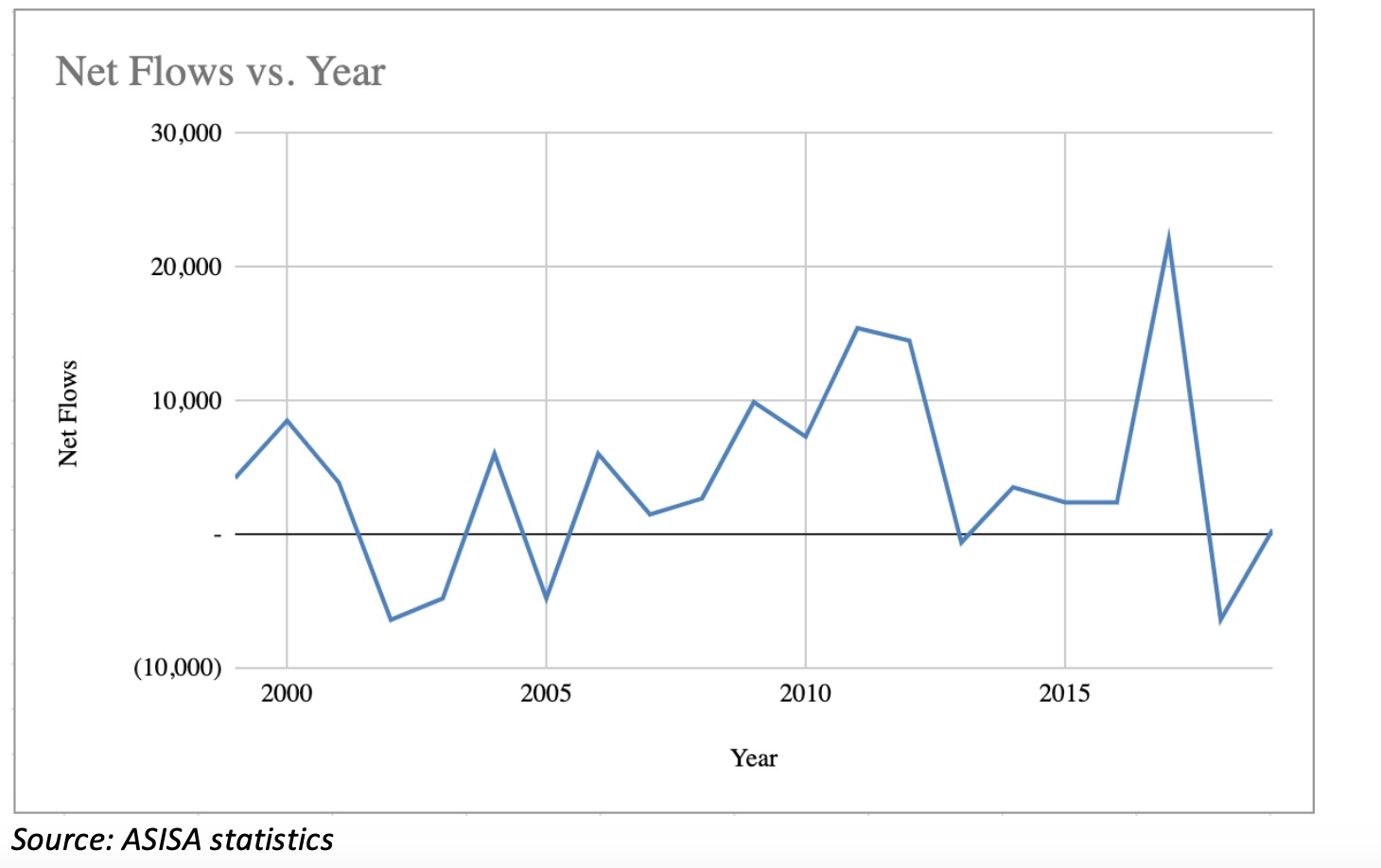BUSINESS MAVERICK
The tide of individual funds leaving SA is swelling

Depression and gloom have settled over the suburbs and the conversation has turned to emigration for those who have the means and the inclination, and offshoring of assets for those who choose to stay. Business Maverick attempted to find out whether this flow of funds has turned into a flood.
Prescribed assets and foreign exchange controls were tools of the apartheid government and some South Africans will remember them well. What they will also remember is that they were the last-ditch tools of a government on the brink of collapse.
The mere suggestion that the government is considering attaching a portion of South Africa’s pension pool to fund state expenditure has inspired panic.
To hear the rhetoric around the braai, every South African with means is considering ways of getting their money out of the country.
To what extent funds are flowing out of the country is relevant. South Africa runs a large current account deficit, largely because imports of goods and services exceed exports. This deficit is financed by inflows of capital investing in government bonds, but also by the South African savings industry which invests in the same government bonds.
South Africans, either directly or via institutions which invest on their behalf, have been investing a portion of their savings abroad since 1994 when foreign exchange control restrictions were first eased.
That said, trying to find out whether more South Africans are using their discretionary allowances than usual, and if so, exactly how much money is flowing out of the country, is difficult.
The South African Reserve Bank (SARB) publishes the balance of payments data, which is the record of all economic transactions between the residents of the country and the rest of the world during a particular period of time.
However, flows are recorded in more than 60 categories and the SARB is reluctant to divulge to what extent individual savings are leaving the country – in the context of the trillions captured in the balance of payment figures it is but a drop in the ocean.
There are different ways of investing offshore
The most common way sees individuals using their R1-million per annum discretionary allowance and investing offshore via foreign currency-denominated unit trusts.
These funds, more than 450 of them, are run by companies that are registered with SA’s financial authorities and are available on investment platforms, such as Allan Gray, Old Mutual, Investec Asset Management, Glacier (by Sanlam) and Momentum
Once invested in these funds, investors can choose whether to return the investment to South Africa, or pay it into an offshore bank account, should they exit the fund.
|
SA’s largest foreign currency denominated investment schemes |
Assets under management in rands |
|
Orbis Global Equity Fund |
64,204,601,685 |
|
Investec Global Strategy Funds |
48,813,256,620.35 |
|
Nedgroup Investment Funds |
44 645 261 159.85 |
|
Stanlib Funds Ltd |
38 259 682 063 |
|
Investec World Axis PCC Ltd |
30 488 413 209.04 |
|
Prudential Global Funds |
21 262 434 453 |
|
Contrarius ICAV |
11 911 810 793.76 |
|
Momentum Mutual Fund ICC Ltd |
11 893 031 481.86 |
Source: Association of Savings and Investment in SA
The flows in and out of these funds are tracked by the Association for Savings and Investment in South Africa.
The graph below shows flows from mid-2000 to mid-2019. It shows that since 2000 South Africans have been investing offshore in a fairly consistent fashion – on average about R6-billion in discretionary income is invested offshore every year. In 2016, R22-billion worth of savings flowed into offshore investments (from individuals and institutions); curiously, in 2018 a net R6.3-billion of offshore investments were converted back into rand, and the trend, according to Asisa is the same in 2019.
Net flows into foreign exchange denominated funds to June 30, 2019

This seems to contradict the notion that South Africans are rushing to offshore their assets.
Sunette Mulder, a senior policy adviser at Asisa, notes that the information tracked by Asisa is submitted on a voluntary basis, and may not be conclusive. Of the figures above, 77% is invested by institutions, and the balance by individuals.
She adds, “There is little stopping people from taking their money out. R1-million a year is a lot of money for most people and they are not necessarily investing it in unit trusts; offshore property is one example of another option.”
Larger amounts require formal exchange control approval and tax clearance from SARS, but it is possible for individuals to move up to R10-million out of the country, per calendar year.
When one excludes institutions from the number, Asisa statistics show that between March and June 2019, South African individual investors invested just R700-million offshore (with the rand hovering between R14 and R14.90/$1), compared to the R2-billion they invested between January and March 2019 (when the rand moved between R13.12 and R14.52 /$1).
Again, this seems to contradict the lived experience.
Tamryn Lamb, head of retail distribution at Allan Gray, has seen these cycles come and go, and adds that “investing offshore is prudent and everyone should have a plan to diversify their savings.
“That said, we are sensing heightened anxiety from investors to place their money offshore which is not yet obviously apparent in the reportable flows data.”
There are a number of other factors at play, but she suggests that investors could be using their offshore allowance to invest directly with offshore institutions like UBS or Credit Suisse.
These fund flows will fall outside the Asisa stats but would be tracked by the SARB.
“Irrespective of what the data confirms, we would encourage investors to continue to exercise careful due diligence, and to evaluate any offshore opportunity within the context of their longer-term plan and goals, and not just as a short-term reaction to concerns about the local political or economic backdrop.”
Acknowledging that it is difficult to put a specific total on the funds flowing out of the country, Sangeeth Sewnath, deputy MD of Investec Asset Management, says one should look for clues to support or reject the theory that funds are flowing out of SA.
For instance, the banks are the conduit for the majority of forex trades in and out of the country. What do they say?
“The sense from the banks is that significant amounts went offshore in 2017, but this slowed in 2018 and remains stable in 2019.”
Emigration is a trend that is hard to miss. An annual FNB survey of estate agents on the reasons for house sales, shows that 7% of sales were due to emigration in 2010, 3% in 2014 and 8% in 2018. In the first six months of 2019 that number has jumped to 13.5%.
This trend was corroborated by Roy Douglas, CEO of ADvTECH, who noted that about 930 children left Crawford schools in 2018 for reasons of emigration, and another 500 so far this year.
SA’s number of assessed taxpayers has fallen considerably over the last 4-5 years, moving from six million taxpayers in 2013 to 4.7 million in 2017. Again, the number is not definitive, but it’s an indicator.
“What these three things tell us, at a macro-level, is that the trend of people and funds moving out of the country is picking up,” says Sewnath.
The reason this may not reflect at an Asisa level is that people are looking for safety – not just from rand/dollar volatility, but equity volatility.
“In the last year we have seen exodus out of general equity and into fixed income and money market funds. People who are nervous locally are putting their money directly into cash offshore or into local money market accounts.”
Farrell Mitchell, director of currency and wealth manager Capta Wealth, says he is seeing a huge shift towards formal emigration among clients.
Part of this is being driven by the change in tax legislation whereby South African tax residents are no longer exempted from paying tax on income from foreign employment.
“This is shifting the behaviour of South Africans who have never formally emigrated. But we are also seeing more middle-class families emigrating.”
Ian Edwards, a partner with financial planning company Austen Morris Associates, adds that the debate about taking money offshore should not be a political or emotional decision – it’s just prudent financial planning.
“We cannot forecast what will happen; we are agnostic, but think it is wise to have a substantial portion of your savings in hard currency. That said, we are seeing an increasing number of enquiries from people wanting to use their offshore allowances,” he says.
“There is a lag in the reported numbers – whether from SARS, the banks, Asisa or the SARB. Thus, it’s possible we are not seeing these trends in the numbers yet,” says Sewnath. BM



















 Become an Insider
Become an Insider